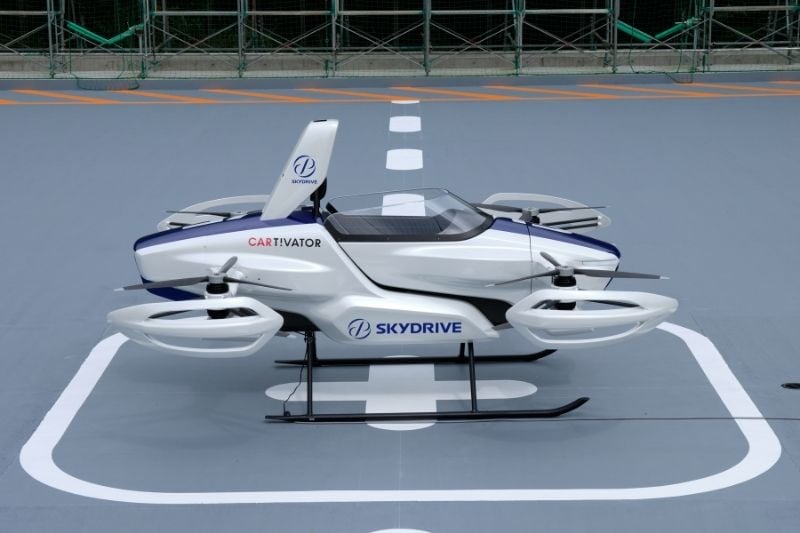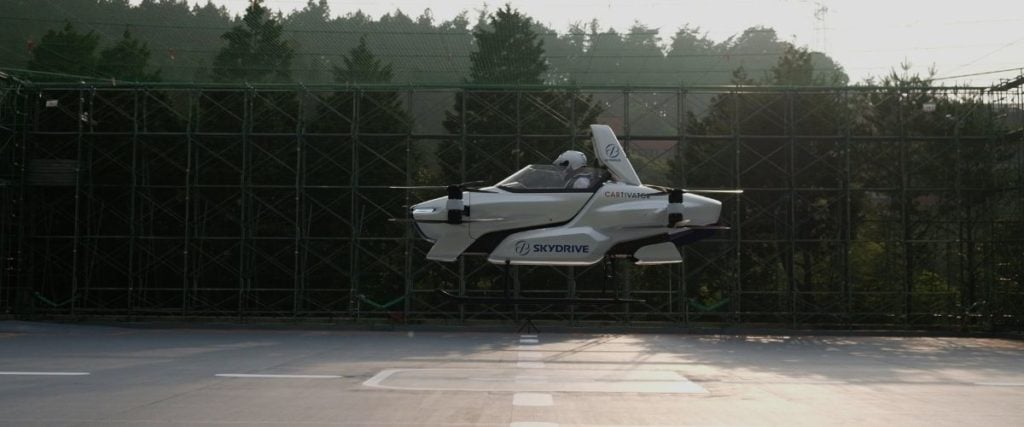Flying cars have been seen in sci-fi movies such as Blade Runner and Back to the Future, but what if we could actually sit in one ourselves?
SkyDrive, a Japanese startup founded in 2012, is seeking to redefine the boundaries of traditional air travel by constructing the world’s first commercially available flying car. After an August flight test demonstration showed the startup’s SD-03 model hovering a few metres off the ground and travelling around an indoor football pitch for four continuous minutes, SkyDrive managed to raise USD 37 million in a Series B funding round, demonstrating the strong faith that investors have placed in the project.
Hive Life sat down with Mr Yoshihiro Kudo, SkyDrive’s Assistant Project Manager, to find out more about the logistics of the vehicle, the next steps in the creation process, and the people behind this groundbreaking (or airbreaking) venture.

What is SkyDrive?
SkyDrive started out in 2012 as a community of volunteers who named themselves CARTIVATOR. The name, derived from a blend of “car” and “cultivator”, reflects the group’s mission in cultivating innovative vehicular experiences. The volunteers consisted of people from various industries who could contribute to the development and eventual release of a potential flying car. This included engineers from the aerospace industry, PR professionals who could help with the marketing aspect of the project, and people from automotive companies, including current SkyDrive CEO, Tomohiro Fukuzawa – a Procurement Officer at Toyota for over six years. Mr Kudo himself comes from a project management background, as he was in charge of managing power plants prior to joining SkyDrive.
The initial idea to develop a flying car was conceived around 2014, and as development progressed, Mr Fukuzawa suggested establishing an entity in order to raise funds for the flying car project. As a result, SkyDrive was officially founded in 2018. Today, its main offices are located in Tokyo, while its development base is located in Fukushima.
How does SkyDrive’s flying car work?
“It helps if you imagine how drones and aeroplanes can fly with the help of propellers – the technology already exists,” says Mr Kudo. The SkyDrive flying car incorporates eight propellers spread out across four locations in its design. The car is powered by electric motors, leading SkyDrive to classify the vehicle as an eVTOL (electric vertical takeoff and landing) – which is defined as a type of aircraft that uses electric power to take off, hover in the air, and land vertically.
In terms of dimensions, the car will be sized around five meters by five meters – the equivalent of approximately two parking slots – and will be between two and three meters tall. Mr Kudo says initial plans are for the flying vehicle to be two-seated upon release, one for a pilot and one for a passenger. Additionally, the current model is able to travel at a speed of around 10km/h, but SkyDrive is hoping its final, commercially available model will be able to travel at speeds of 40 to 50 km/h.
The Development Process
“Many kinds of people contribute to SkyDrive in their own ways,” Mr Kudo explains. People from the aerospace industry help with the physics of flying in the air. People from the software industry contribute to the development of the software control system. Mr Kudo himself used to manage a gas power plant and a coal-fired power plant. “It’s not really the same, technically, but the basics of project management are applicable in this business too,” he asserts.
After the August flight test demonstration video which showed promising results, SkyDrive has continued tackling various design issues. The startup uses what Mr Kudo calls a “flying duck” model as the basis of its vehicle, and will be utilising the model in future tests as well in order to obtain more data. However, SkyDrive is also exploring other options as a basis for the model, and are currently engaged in discussions with the Ministry of Land, Infrastructure, Transport and Tourism (MLIT) to obtain certification for potential future models.

Operation
Unlike some other single-seater flying cars developed by other aerospace companies, including the Vahana eVTOL developed by aerospace giant Airbus, SkyDrive has opted for two seats in its aerial vehicle. Mr Kudo reasons that although the vehicle will mostly operate automatically, there may be certain situations – such as dangerous weather conditions – in which a trained pilot will be required to take control, in order to safely navigate and land the vehicle.
“Safety is a very important issue to us,” Mr Kudo emphasises. At the moment, SkyDrive’s flying cars are classified as aeroplanes, so for now, they have to stick to regulations established for aeroplanes and helicopters. Rules governing the usage of eVTOLS in civilian areas haven’t been established in Japan yet, and SkyDrive is working in tandem with the MLIT to create new eVTOL-specific regulations. A particular point of concern is the minimum operating altitude that its vehicles will have to adhere to; currently, SkyDrive vehicles have to maintain an altitude of at least 150 metres, but as Mr Kudo points out, it’s very difficult to land a flying car from that height, and it’s also inefficient to travel at such an altitude, especially across shorter distances.
With regards to parking, SkyDrive is looking into establishing control centres at various locations across Japan to coordinate the process of landing flying cars safely. “In certain situations where we need to park on the ground, and there are people nearby, we’ll need to be able to communicate with people on the ground who can verify that there are no people around the parking area,” Mr Kudo states. Additionally, SkyDrive is also looking into constructing a communication system for eVTOLS specifically, allowing them to be able to communicate with each other whilst airborne if/when necessary.
Timeline and Release Details
Although SkyDrive is seeking to eventually operate its vehicles in urban areas, it’s a difficult task to accomplish immediately, given the inherent risk of flying vehicles at such low altitudes over people’s heads. The startup will be testing its vehicles over the next few years in the Osaka Bay Area, located in western Japan. “With our flying car, the trips will be short and hopefully even fun,” Mr Kudo comments. The Osaka Bay Area is an ideal location for open-air tests of the flying car, as there is plenty of water surrounding the area on which the cars can land in case of unexpected emergencies.
SkyDrive hopes to release its flying cars onto the market by 2023, with a starting price of USD 500,000. After they’re able to begin mass production of the vehicles, however, Mr Kudo estimates the price of the cars could drop down to around USD 50,000. By 2025, SkyDrive is also hoping to implement its very own taxi service in the Osaka Bay Area, utilising its flying vehicles to help citizens cut down on commuting struggles, as well as providing them with a unique travel experience. Finally, SkyDrive hopes to complete its automatic piloting technology by 2028, to enable all of its flying cars to be operated with full autonomy by 2030.
According to Mr Kudo, Southeast Asian countries with denser populations – such as Hong Kong – are the target areas for potential future SkyDrive expansions. But Mr Kudo isn’t getting too ahead of himself just yet. “We want to operate our flying cars in foreign countries, but obviously, we need to first successfully launch our product in Japan,” Mr Kudo concludes. Considering how promising SkyDrive’s ambitious project looks, perhaps Back to the Future isn’t that far off at all – although the final product probably won’t resemble a DeLorean.
Related Articles
‘TRAIN’ing: Geofencing App Helps Tokyo Commuters Stay Active
This Japanese Scientist Created an AI Therapy Robot for Elderly Patients





